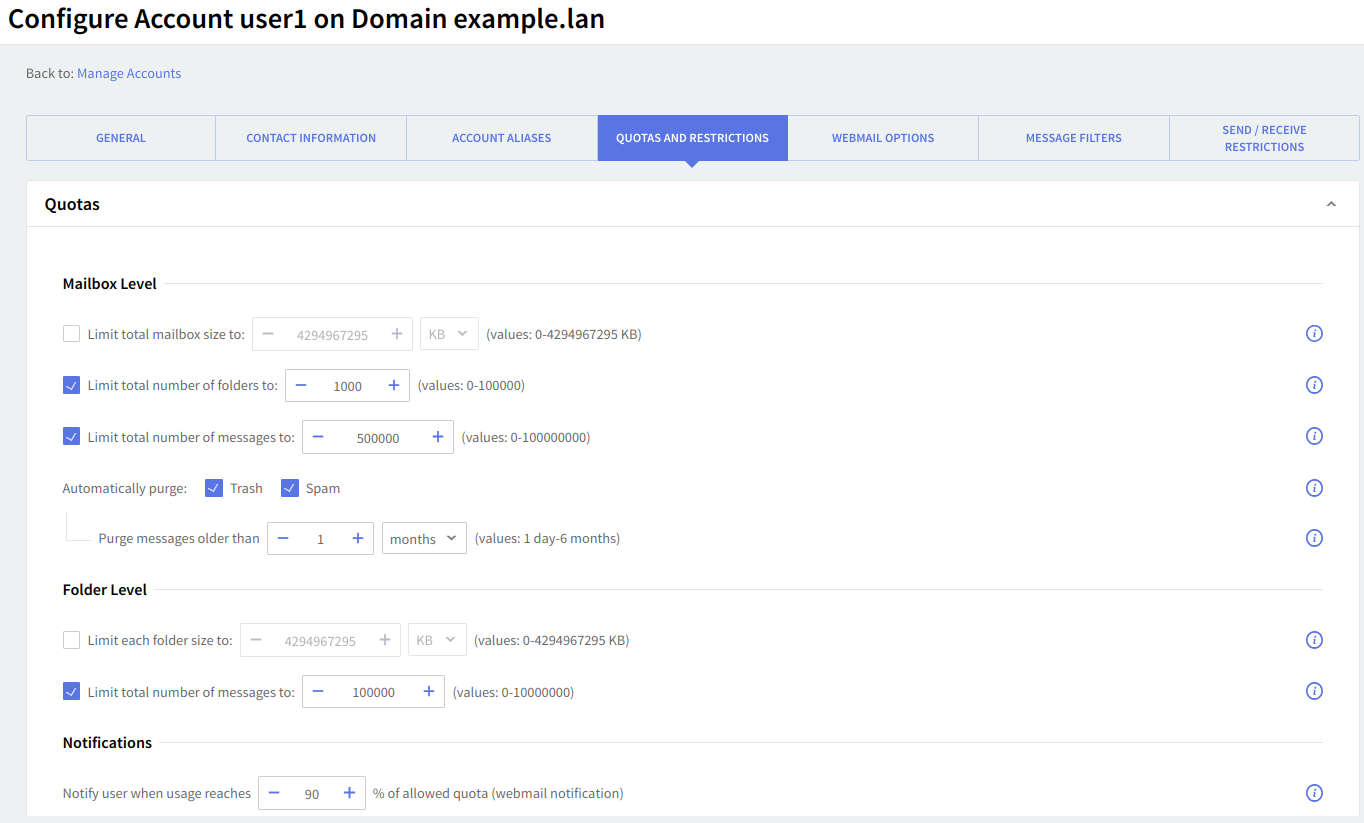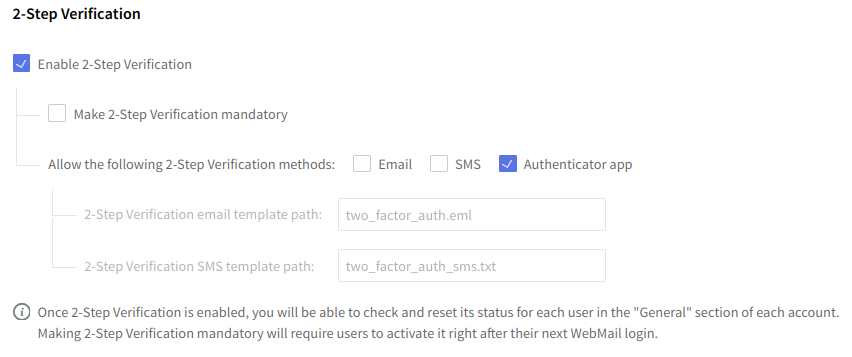
At the mailbox level, the total mailbox size, the total number of folders, and the total number of messages can be limited by selecting the respective options in the "Mailbox" area and using the up and down arrows to adjust the limits to the desired value. For the total size limit, use the available drop-down menu to select if you want it calculated in KB, MB, or GB.
In addition, you can have older messages in the Trash and/or Spam folders automatically purged, based on age criteria. By default, this option is enabled to purge messages older than 1 month.
At the folder level, you can set limits for the size of each folder and the total number of messages per folder by checking the respective options in the Folders section and using the up and down arrows to adjust the limits to the desired value. For the folder size limit, use the available drop-down menu to select if you want it calculated in KB, MB, or GB. The maximum possible value for "total size limit" is 1 KB lower than 4096 GB.

To notify the account user (through a pop-up displayed when accessing the WebMail interface) when a certain level of the allowed quota is reached, check the respective option in the 'Notifications' area and edit the default percentage. You can also choose to have the user notified at every login via an email and control the frequency of these login notifications. The frequency of these login notifications can be set using the up and down arrows corresponding to this additional option. To select if the respective value is calculated in minutes, hours or days use the respective drop-down menu.
There is an option to restrict the user from sending any new emails when he reaches a specific used quota percentage. By default this is set to 0%, so the user will be able to send emails until he reaches his quota. The percentage you set for this option must be higher than the quota usage warning percentage.

In this section you can disallow the user from changing it's personal contact information, restricting access to the corresponding contact details.

You can define a Password Policy to be enforced for the currently created account. First of all, a minimum and maximum number of characters for each password can be set using the up and down arrows or directly editing the Password length parameters text field. Further, select from the Password must include a drop-down menu if passwords should include letters, letters, and numbers or letters, numbers, and special characters. You can also set specific password-changing options like the number of previous passwords that should not be accepted as the new password, a minimum period between two password changes, and if the user is allowed to change the password.
Password Expiration
In this section you can enable, by checking the related box, the "Enable password expiration" option and then customize the password expiration and related notifications in compliance with your requirements.


The number of POP3, IMAP, and WebMail sessions can be limited for the respective account. To do so select the desired value, use the up and down arrows, or directly edit the text fields pertaining to each type of session.
2-Step Verification

2-Step Verification Settings
This section allows administrators to configure 2-Step Verification (2SV) settings to enhance account security for users.
-
Enable 2-Step Verification:
-
To activate 2SV, check this box. Enabling 2SV allows users to add an extra layer of security to their login process by using a secondary verification method.
-
-
Make 2-Step Verification Mandatory:
-
Enabling this option will require all users to set up 2SV immediately after their next login. If left unchecked, 2SV will remain optional for users.
-
-
Allow the following 2-Step Verification methods:
-
Choose one or more methods for 2SV:
-
Email: Sends a 2SV code via email.
-
SMS: Sends a 2SV code via SMS.
-
Authenticator app: Generates a code via an authenticator app (such as Google Authenticator).
-
Note: Only the methods that are enabled will be available to users for verification.
-
-
2-Step Verification email template path:
-
Specifies the file path for the email template used in 2SV emails. This field is active only if the Email method is selected.
-
-
2-Step Verification SMS template path:
-
Specifies the file path for the SMS template used in 2SV SMS messages. This field is active only if the SMS method is selected.
-
Important: After enabling 2-Step Verification, you can manage and reset 2SV settings for individual users in the "General" section of each user account. Making 2SV mandatory will prompt users to activate 2SV upon their next login to WebMail.
WebMail Advertising

In the "WebMail Advertising" area, you can configure the three advertising sections of the interface (only pertaining to AJAX WebMail interface) by inserting appropriate HTML code in the corresponding parts. We recommend respecting the maximum size specified for each section.
WebMail Message Limits

To limit the size of email message attachments uploaded via the WebMail interface, check the respective option in the WebMail section and use the up and down arrow to select the desired size. To have the size measured in KB, MB or GB use the available drop-down menu.
Use the up and down arrows of the "Limit number of attachments per message" option or edit its corresponding text field to set the maximum number of attachments allowed to email messages sent or received using the WebMail interface.
Check the "Limit message size" option to set a maximum size for sent and received messages through the WebMail interface. To do so either use the up and down arrows to select the desired size or edit the corresponding text field.
The "Limit number of recipients" option allows you to configure a maximum number of recipients for WebMail email messages using the up and down arrows to select the desired size or edit the corresponding text field.
External apps allow users to add Zoom and Microsoft Teams conference links and meeting details to their WebMail calendar events, but only after the administrator has both configured and enabled the Zoom and/or Microsoft Teams integration.
To set the HTML Body Filtering Level for this specific account when connected via WebMail use the available slider. The HTML filtering levels stand for the following:
-
No Filtering;
-
Low level filtering – converts the message to standard XHTML;
-
Medium level filtering – generates the email body based on a list of known/allowed attributes and tags. Anything that is not on this "allowed list" is removed. This level removes java script, styles, etc.;
-
High level filtering – generates the email body based only on text components. This means that only plain text components remain in the message. This forth level is the strictest and may actually damage some formatting, but it is also the safest.
A minimum email body filtering restriction can be applied by dragging the "Minimum allowed HTML Body Filtering Level" slider to the desired setting. This will not allow the user to set the email body filtering level (from WebMail) to a lower value than the one specified in WebAdmin.
Default Domain Sharing Permissions

The permission to use Default Domain Sharing Permissions can be enabled or disabled from this section, by checking/unchecking the related boxes.
Filtered Email
The permission to use Filter Email can be enabled or disabled from this section, by checking/un-checking the related boxes. You can limit the Filtered Email folder size quota with the up/down set of arrows for the value and a drop-down value box. Also, you may limit the Filtered Email Count quota from values between 0-10000000.
Remote POP
You can limit the number of remote POP accounts defined by a certain user. To do so, use the up and down arrows to select the desired size or edit the corresponding text field. Additionally, a minimum interval between two email retrievals for each RPOP connection can be specified. Use the "Minimum message retrieval interval" drop-down menu to have it calculated in minutes, hours or days.
Temporary Email Addresses Restrictions
You can set some limits regarding the usage of temporary email addresses. A user may request maximum 16 temporary email addresses (aliases), if the limit is set to "0" the "Add" button in WebMail (in the "Temporary Email Addresses" section) will be disabled but the old temporary email address will still be available until they expire or are deleted. The period from the creation of a temporary email address to its automatic deletion can be set between 10 minutes and 1 year.
Parameter inheritance: the parameters or parameter groups that are inherited from the domain's account defaults are automatically marked with the "Inherited from domain's account defaults" icon, while the ones inherited from an account class are marked with the "Inherited from account class" icon. When explicitly setting the value of an inherited parameter, it will be marked with the Set explicitly icon. Moreover, any further changes at the parent level (domain's account defaults or account class) will only affect inherited parameters, while explicitly set ones will keep their value. You can revert the explicit parameters to their inherited value at any time by clicking the "Inherit" link related to the explicitly set parameter (orange) icon.

Icons:
Once your changes are complete, save them by clicking the "Save Configuration" button.


